What Symbol Does a Yellow Butterfly Represent?
The yellow butterfly, known for its vivid color and graceful flight, symbolizes transformation, hope, and spiritual rebirth across diverse cultural and spiritual backgrounds. In Japanese tradition, it represents joy and longevity, while Mexican customs link it to the Day of the Dead.
Spiritually, it is viewed as a messenger from the divine, symbolizing heightened intuition and inner awakening. Entomologically, it embodies resilience and the transformation journey from larva to adult.
This fragile insect bridges the physical and celestial domains, offering solace and connection. For more detailed insights into its cultural and spiritual symbolism, continue exploring the intricate tapestry it weaves.
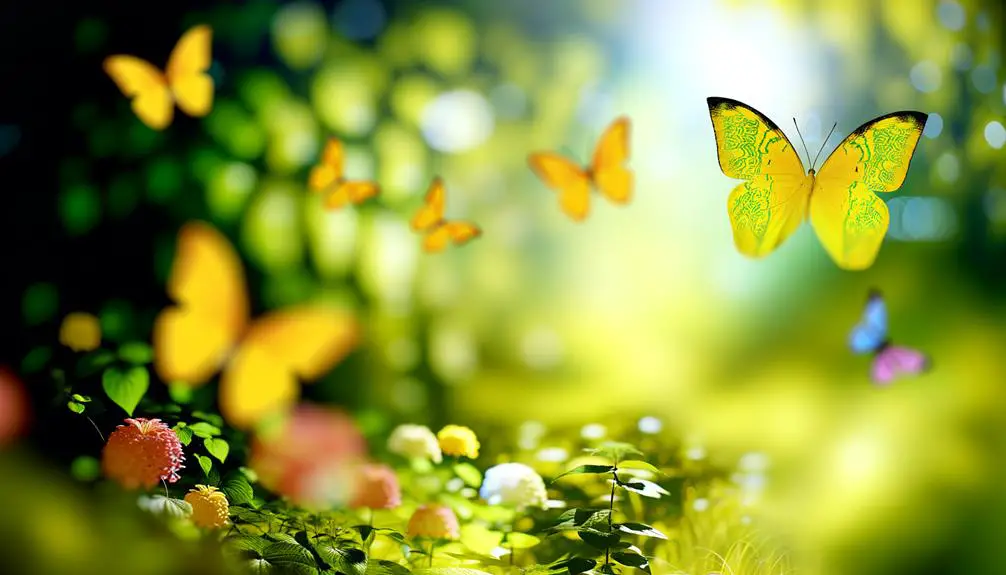
Key Takeaways
- Yellow butterfly symbolizes transformation, hope, and spiritual rebirth across various cultures.
- It represents optimism, resilience, and the triumph of hope over adversity.
- Seen as a messenger from the divine, symbolizing spiritual growth and renewal.
- Associated with visits from departed loved ones, offering comfort and connection.
- Frequently used in art to convey themes of transformation, beauty, and the ephemeral nature of existence.
Cultural Significance
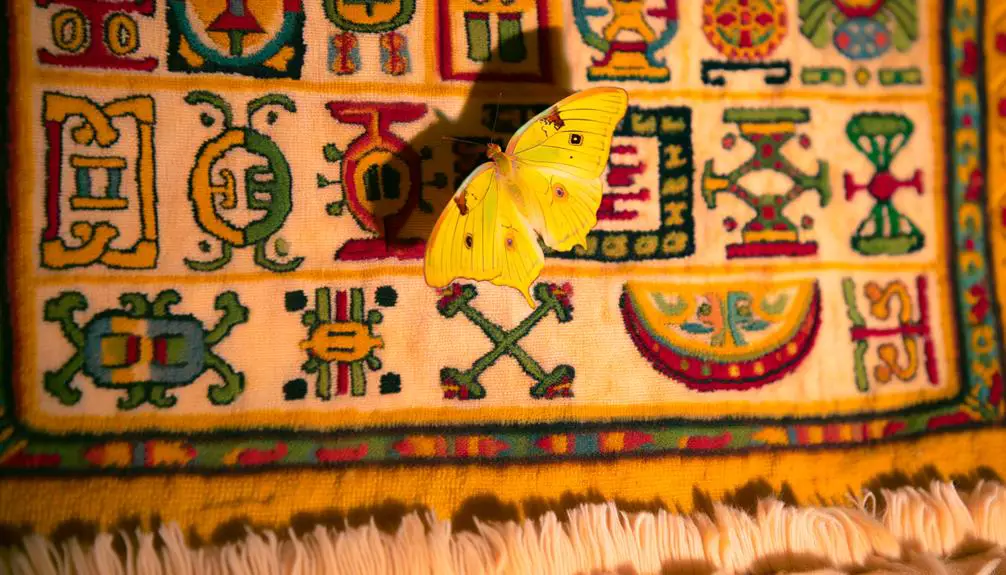
The yellow butterfly holds varying degrees of cultural significance across different societies. It often symbolizes transformation, hope, and spiritual rebirth. In various anthropological studies, this lepidopteran is frequently associated with metamorphosis due to its life cycle from larva to imago.
Detailed observations reveal that in Japanese culture, the yellow butterfly, or 'kiiroi chō,' signifies joy and longevity. Similarly, in Mexican traditions, it is linked to the return of souls during the Day of the Dead. Ethnographic evidence indicates that in Western cultures, yellow butterflies are omens of positive change and new beginnings.
These cultural attributions are supported by entomological studies that highlight the insect's vibrant coloration and dynamic flight patterns as potent symbols in folklore and ritualistic contexts.
Spiritual Meanings
Yellow butterflies often serve as powerful spiritual symbols, representing the soul's journey and transformation across various metaphysical traditions.
In many spiritual frameworks, these lepidopterans are seen as messengers from the divine, symbolizing metamorphosis and the cyclical nature of existence. The chromatic intensity of their wings is often associated with solar energy, energy, and enlightenment.
Additionally, in esoteric practices, the yellow butterfly is thought to be an emblem of heightened intuition and inner awakening. This belief is rooted in the notion that the butterfly's life stages—from larval to pupal to adult—mirror the human spiritual evolution.
Consequently, encountering a yellow butterfly is frequently interpreted as an auspicious sign of spiritual growth and renewal, reinforcing its esteemed position in spiritual symbolism.
Symbol of Hope
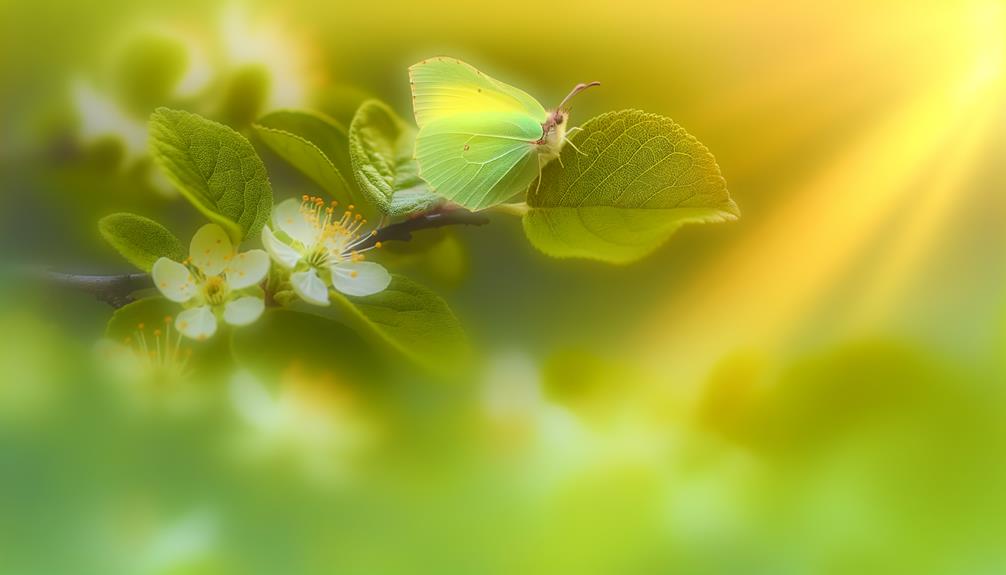
The yellow butterfly, often observed in various cultural and ecological contexts, serves as a potent symbol of hope, particularly in relation to overcoming life's challenges and embracing new beginnings.
Its metamorphic lifecycle—from larva to chrysalis to adult butterfly—mirrors the human experience of transformation and resilience.
This correlation between the butterfly's development and human adaptability underscores its emblematic significance in conveying optimism and renewal.
Overcoming Life's Challenges
Emerging as an emblem of resilience, the yellow butterfly symbolizes the triumph of hope over adversity in the natural world. This lepidopteran's life cycle, from egg to larva, pupa, and finally adult, mirrors the arduous journey of overcoming life's challenges.
Metamorphosis, a complex biological process, involves substantial physiological transformations, including histolysis and histogenesis, where larval tissues are broken down and restructured into adult forms. Such intricate adaptations exemplify the capacity to endure and flourish despite environmental pressures and predatory threats.
Moreover, the yellow butterfly's vibrant coloration serves as a form of aposematic signaling, deterring potential predators and enhancing survival odds. Through this lens, the yellow butterfly is not merely a symbol but a tribute to nature's inherent ability to surmount obstacles.
Embracing New Beginnings
As a natural indication of resilience, the yellow butterfly further embodies the concept of embracing new beginnings, symbolizing hope through its metamorphic transformation and subsequent emergence into a vibrant, winged adult. This biological process, involving stages from egg, larva, pupa, to adult, encapsulates the essence of regeneration and renewal. Observing the yellow butterfly's lifecycle offers profound insights into resilience and adaptation, both essential for thriving in changing environments.
| Stage | Description |
|---|---|
| Egg | Initial stage, often laid on leaves |
| Larva | Caterpillar phase, marked by growth |
| Pupa | Transformative phase, chrysalis form |
| Adult | Emergence of butterfly, full maturity |
Understanding these stages elucidates the yellow butterfly's role as a symbol of hope, accentuating the importance of embracing new beginnings.
Transformation and Change
The yellow butterfly epitomizes transformation and change, reflecting nature's metamorphosis journey from larva to adult. This process illustrates distinct, symbolic life stages, each embodying concepts of growth and renewal.
Observing this metamorphosis offers insights into the biological mechanisms underpinning development and the broader implication of embracing new beginnings.
Nature's Metamorphosis Journey
In the life cycle of the yellow butterfly, the process of metamorphosis—from egg to larva, pupa, and finally to adult—exemplifies a remarkable biological transformation and adaptation.
During the larval stage, the caterpillar undergoes rapid growth and molts multiple times, a process termed ecdysis. Each molt signifies a new instar, a stage between periods of molting.
The larva then forms a chrysalis, undergoing histolysis and histogenesis, where larval tissues are broken down and adult structures are formed. This pupal stage is pivotal for the reorganization of tissues, driven by hormonal regulation, such as ecdysteroids and juvenile hormones.
Upon eclosion, the adult butterfly emerges, completing its intricate metamorphic journey, showcasing nature's profound capacity for transformation and renewal.
Symbolic Life Stages
Metamorphosis in yellow butterflies serves as a potent symbol of transformation and change, illustrating the profound biological and metaphorical implications of growth through distinct life stages. The life cycle of a yellow butterfly encompasses four essential stages: ovum (egg), larva (caterpillar), pupa (chrysalis), and imago (adult butterfly). Each stage represents a significant phase of development:
- Egg Stage: The inception of potential, where life begins in a microscopic yet intricate form.
- Caterpillar Stage: A period of voracious growth and accumulation of resources, reflecting preparation and perseverance.
- Chrysalis Stage: The transformative phase, a seemingly dormant period harboring intense reorganization and metamorphosis.
These stages encapsulate the essence of personal and biological evolution, embodying resilience and profound change.
Embracing New Beginnings
Embracing new beginnings in the domain of yellow butterflies requires a thorough understanding of their adaptive strategies and physiological changes that enable successful transformation and survival.
During metamorphosis, yellow butterflies undergo holometabolism, encompassing four distinct stages:
egg,
larva,
pupa, and
adult.
Larvae exhibit remarkable adaptability through dietary specialization and defensive mechanisms such as aposematism.
The pupal stage, or chrysalis, involves profound physiological reorganization, facilitated by the hormone ecdysone, leading to the emergence of the adult butterfly.
This transformation is not merely physical but encompasses behavioral adaptations essential for foraging, mating, and migration.
Understanding these intricate processes provides invaluable insights into the resilience and adaptability of yellow butterflies, underscoring their symbolic representation of new beginnings and continuous evolution.
Connection to Loved Ones
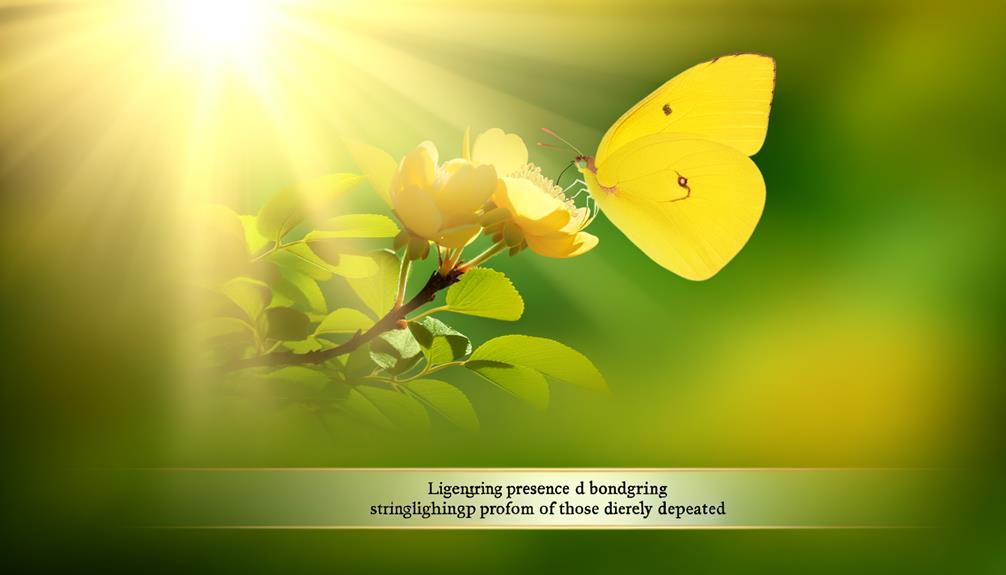
The yellow butterfly is often perceived as a symbol of connection to loved ones, particularly in the context of spiritual or emotional bonds that transcend physical presence. This lepidopteran is frequently associated with the ethereal and intangible aspects of human relationships due to its delicate and transient nature. Such symbolism is deeply rooted in various cultural and psychological domains.
- Spiritual Visitations: Many believe that a yellow butterfly signifies a visit from a departed loved one, bridging the physical and ethereal domains.
- Emotional Resonance: The visual and vibrant presence of a yellow butterfly can evoke cherished memories and emotional responses linked to loved ones.
- Symbolic Communication: In moments of grief or longing, the appearance of a yellow butterfly is interpreted as a comforting sign of ongoing connection.
Yellow Butterfly in Art
In the field of visual arts, the yellow butterfly has been employed as a potent symbol to convey themes of transformation, beauty, and the ephemeral nature of existence.
Artists utilize the yellow butterfly to epitomize the metamorphosis process, reflecting profound changes and the fleeting moments of life. Techniques such as chiaroscuro and sfumato are often applied to render the delicate wings, emphasizing their transient beauty.
Through compositions in both traditional and contemporary media, the yellow butterfly is depicted in various stages of flight and rest, symbolizing life's impermanence. The coloration, achieved through pigments and digital methods, highlights the butterfly's luminosity, serving as a visual metaphor for enlightenment and rebirth.
This symbolic usage enriches the narrative depth and emotional resonance of artworks.
Personal Reflections
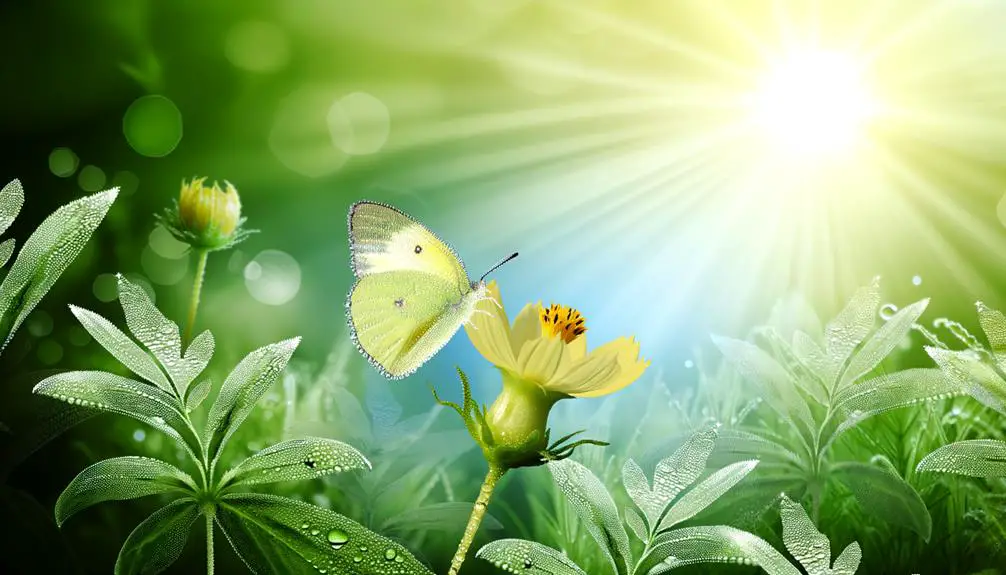
Reflecting on the symbolic significance of the yellow butterfly, one can appreciate its profound impact on personal experiences, particularly in its representation of transformation and the transient nature of human existence. The yellow butterfly, with its delicate wings and ephemeral lifespan, serves as a poignant reminder of life's fleeting moments and the potential for personal growth.
Observations reveal that individuals often associate this emblem with:
- Metamorphosis: Signifying the transformative journey from one stage of life to another.
- Ephemerality: Highlighting the impermanence of moments and the importance of cherishing them.
- Hope and Renewal: Inspiring optimism and the possibility of new beginnings.
Scientifically, the yellow butterfly exemplifies the Lepidoptera order's diverse adaptive strategies, mirroring human resilience and capacity for change.
Conclusion
The yellow butterfly, a symbol laden with cultural, spiritual, and artistic significance, embodies notions of hope, transformation, and connection to the departed.
Ironically, in the pursuit of metamorphosis, the butterfly's ephemeral existence highlights the transient nature of life.
Despite its delicate form, it catalyzes profound personal and collective reflections.
Consequently, while admired for its beauty and symbolism, the yellow butterfly serves as a poignant reminder of the fleeting and ever-changing essence of existence.






